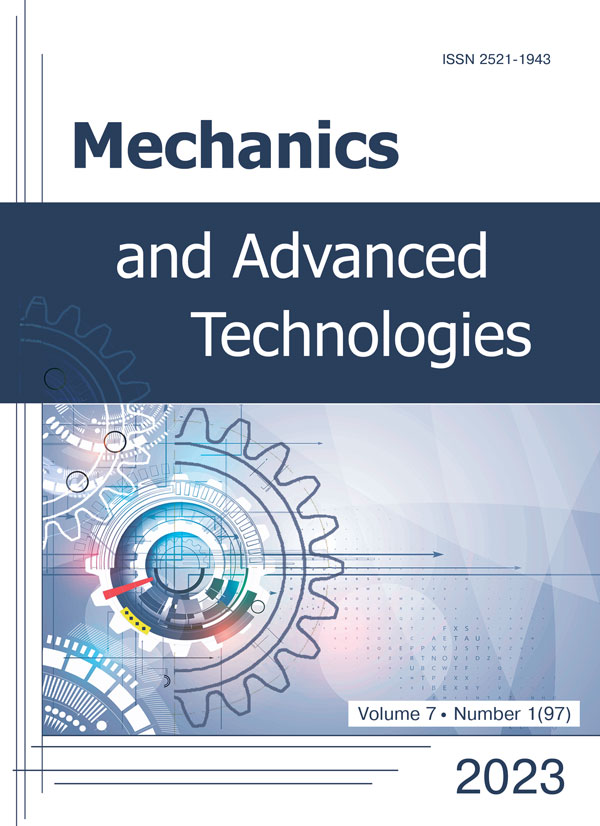Technology and mechanical properties of reinforced continuous fiber 3D-printed thermoplastic composite
DOI:
https://doi.org/10.20535/2521-1943.2023.7.1.266177Keywords:
additive manufacturing, fused deposition modeling, extruder, polylactid acid, kevlar, composite, mechanical propertiesAbstract
Background. Additive technologies based on Fused Deposition Modeling (FDM) modeling methods attract a lot of attention from both industry and research groups, which is explained by low investment costs, ease of production, etc. If the processing parameters are correctly selected, products with mechanical properties close to products obtained by traditional technologies can be obtained.
Objective. Practical implementation of the modernized technology for 3D printing of Polylactid Acid (PLA) samples reinforced with continuous Kevlar fiber using the FDM method and determination of their mechanical properties.
Methods is based on experimental and theoretical studies of the limit of tensile strength and modulus of elasticity of the composite and includes testing of samples on the SHIMADZU AGS-X testing machine and solving the inverse problem.
Results. Experimental samples of thermoplastic composite (PLA+Kevlar fiber Æ0.3 mm) were tested for tension. It was found that the tensile strength of the reinforced composite compared to the unreinforced one with a Kevlar volume fraction of about 12% increases by 2.38 times, and the modulus of elasticity increases by 1.45 times. With a confidence interval of 0.68, the error of determining the ultimate tensile strength is 3.5%, and the modulus of elasticity is 4.5%. A theoretical dependence was obtained for predicting the modulus of elasticity of thermoplastic composites in the range of changes in the degree of reinforcement up to 15%.
Conclusions. The application of additive technologies based on FDM for 3D printing of thermoplastic composites with increased mechanical properties is substantiated.
References
- W. M. H. Verbeeten, and M. Lorenzo-Bañuelos, “Material Extrusion Additive Manufacturing of Poly(Lactic Acid): Influence of infill orientation angle”, Additive Manufacturing, vol. 59, pp. 10307911-16, 2022. doi: https://doi.org/10.1016/j.addma.2022.103079
- B. Turner, R. Strong, and S. Gold, “A review of melt extrusion additive manufacturing processes: I. Process design and modeling”, Rapid Prototyp J., vol. 20, no. 3, pp. 192–204, 2014. doi: https://doi.org/10.1108/RPJ-01-2013-0012
- Y. Zhuang, B. Zou, S. Ding, and P. Wang, “Shear and Tensile Behaviors of Fiber-Reinforced Resin Matrix”, Composites Printed by the FDM Technology. Coatings, vol. 12, pp. 1000-1-13, 2022. doi: https://doi.org/10.3390/coatings12071000
- S. Rijckaert, L. Daelemans, L. Cardon, M. Boone, W. Van Paepegem, and K. De Clerck, “Continuous Fiber-Reinforced Aramid/PETG 3D-Printed Composites with High Fiber Loading through Fused Filament Fabrication”, Polymers, vol. 14, pp. 298-1-16, 2022. doi: https://doi.org/10.3390/polym14020298
- F. Lupone, E. Padovano, C. Venezia, and C. Badini, “Experimental Characterization and Modeling of 3D Printed Continuous Carbon Fibers Composites with Different Fiber Orientation Produced by FFF Process”, Polymers, vol. 14, pp. 426-1-26, 2022. doi: https://doi.org/10.3390/polym14030426
- J. Singh, R. Singh, and S. Sharma, “Effect of processing parameters on mechanical properties of FDM filament prepared on single screw extruder”, Materials Today: Proceedings, vol. 50, part 5, pp. 886-892, 2022. doi: https://doi.org/10.1016/j.matpr.2021.06.166
- V. V. Solovei, and V. O. Oleksyshen, “Doslidzhennia fizyko-mekhanichnykh vlastyvostei kompozytnykh materialiv otrymanykh z vykorystanniam adytyvnykh tekhnolohii”, Visnyk NTUU «KPI im. Ihoria Sikorskoho». Khimichna inzheneriia, ekolohiia ta resursozberezhennia, no 1(20), pp. 9–21. 2021. doi: https://doi.org/10.20535/2617-9741.1.2021.228078
- SHIMADZU. AGS-X Series Universal Electromechanical Test Frames. https://www.ssi.shimadzu.com/products/universal-tensile-testing/ags-x-specifications.html [Accessed Jan. 25, 2021].
- A. N. Zaidel', Elementarnye otsenki oshibok izmerenii. Leningrad: Nauka, 1968.
- A. Yu. Pedchenko, Ye. M. Panov, A. Ya. Karvatskii, S. V. Leleka, and T. V. Lazarev, Teoretychno-eksperymentalni doslidzhennia pechei grafituvannia Kastnera, Kyiv: Igor Sikorsky Kyiv Polytechnic Institute, 2017. http://ela.kpi.ua/handle/123456789/20800
- V. V. Solovei, A. Ya. Karvatskii, T. V. Lazariev, I. O. Mikulonok, and I. V. Omelchuk, “Vyznachennia mekhanichnykh vlastyvostei 3D-drukovanykh polimernykh vyrobiv metodamy strukturnoi mekhaniky”, Visnyk NTUU «KPI im. Ihoria Sikorskoho». Khimichna inzheneriia, ekolohiia ta resursozberezhennia, no 2(20), pp. 16–32, 2021. doi: https://doi.org/10.20535/2617-9741.2.2021.235853
Downloads
Published
How to Cite
Issue
Section
License
Copyright (c) 2023 Антон Карвацький, Владислав Соловей

This work is licensed under a Creative Commons Attribution 4.0 International License.
Authors who publish with this journal agree to the following terms:
- Authors retain copyright and grant the journal right of first publication with the work simultaneously licensed under CC BY 4.0 that allows others to share the work with an acknowledgement of the work's authorship and initial publication in this journal.
- Authors are able to enter into separate, additional contractual arrangements for the non-exclusive distribution of the journal's published version of the work (e.g., post it to an institutional repository or publish it in a book), with an acknowledgement of its initial publication in this journal.
- Authors are permitted and encouraged to post their work online (e.g., in institutional repositories or on their website) prior to and during the submission process, as it can lead to productive exchanges, as well as earlier and greater citation of published work





